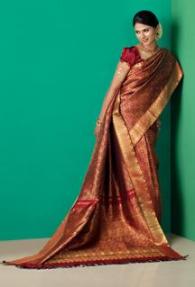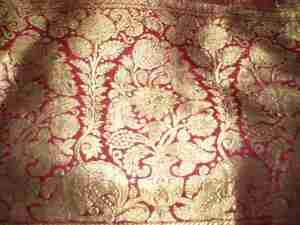Silk sareesare given a unique status in Indian weddings be it north, south, east
or west, and an Indian bride’s trousseau is considered incomplete without one. Sarees for marriages are chosen with a lot of care. In fact an auspicious day is set aside for the purchase of wedding sarees and displaying them is a small ceremony in itself.
Each silk saree carries a legacy of art with it, while it is cherished and passed on to the future generations.
The type of silk saree could be a Kanjeevaram, Banarasi, Paithani, Patola, Tanchoi, Pochampally …… There is indeed a big list. These saris come in a mind-boggling variety of textures, colors and designs, all woven on silk.
Each type belongs to a class of its own, depending upon the region where it originates. Here are some details of a few of them.

The traditional Kanchivaram silk - available at http://www.rmkv.com
Kanchivaram
Kanchivarams are saris from south. These saris are well known for their texture their bold and bright colours, and zari borders which are worked entirely with silk and gold thread. Weddings are synonymous with kanchivaram saris. Every woman at a south Indian marriage will turn out in some variety of the Kanchivaram.
Banarasi
A Banarasi is to a north Indian bride what a Kanjeevaram is to a bride from the south. There is hardly a north Indian bride whose trousseau does not include a Banarasi sari. It is considered customary to include one.
Weaving of brocades with intricate designs using gold and silver threads are the speciality of the Banarasi sari. They can be quite heavy sometimes if the patterns are worked throughout the entire length of the sari.
Jamawar Tanchoi
The Jamawar Tanchoi is an off shoot of the Banarasi. Adopting patterns from Kashmiri shawls, they look extremely elegant in their intricate patterns.
Paithani
The Paithani Saris even today follow traditional methods of weaving. Painstakingly woven, sometimes a Paithani sari can take a couple of months to be made depending on the pattern. Originating in Maharashtra, it is believed that there are references to the Paithani sari in some ancient poems and stories.
Patola
Patola Silk Sarees from Gujrat are one of the finest varieties of handloom silk. Geometric designs with folk motifs are characteristic features of the Patola saris. Patola is one of the most difficult forms of weaving, as the threads for the weft and warp are dyed separately for the desired effect.
Zardozi
Zardozi work on silk saris is quite common at weddings as they lend grandeur to the sari. Worked with gold and silver threads and artistically embroidered with kundan sequins, these saris are particularly favoured for their art and trendy appeal.
The common feature among all these saris is not just the intricate designs, flamboyant colours and the silken texture but their durability too. After all, wedding saris are not just made for a lifetime – but to outlive it.

